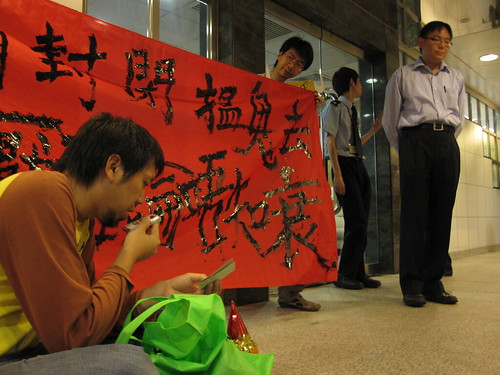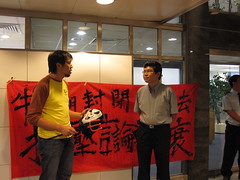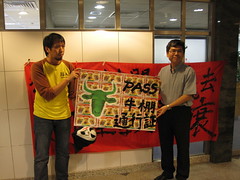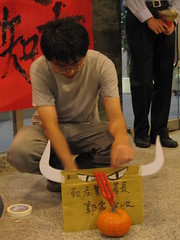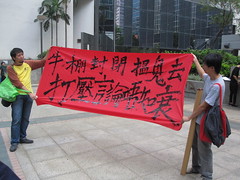Stringent government regulations restrict access to an artist’s village in Kowloon. But what good is art if so few people can enjoy it, asks Grace Tsoi.
To Kwa Wan is an old district lined with tong laus, Hong Kong-style walk-up tenement buildings. But what stands out is a former slaughterhouse with red-brick walls and colonial architecture. Built before World War I, the Ex-Ma Tau Kok Animal Quarantine Depot is made up of five buildings with a large open space in the middle; the government has been renting local artists studio and exhibition space there since 2001.
On the surface, the historical location seems to offer up the ideal setting for creative expression and community building. However, the government’s restrictive management and lack of vision has been strangling the village’s growth into a vibrant art space in the city.
Quiet and lifeless, a passer-by would probably never notice the Cattle Depot Artist Village. There are very few visitors and no outdoor displays—over the entire space of 0.7 hectares. Even for those in the know, it is still difficult to gain entry. Hawk-eyed security guards man the door, because guests are only allowed in with an invitation card. In the nine years since its establishment, the village has never been open to the public; even neighborhood residents are not allowed to enter the area.
“It would be great if we could walk around and enjoy it,” said Kuam Sheui-yin, 72, who has been living in To Kwa Wan for more than 40 years. “It is a big waste of space, because the elderly who are living just opposite to the depot cannot enter the artist village. We also want to enjoy art; it is not too difficult for us to understand.”
“Even though artists and residents are just separated by one block, we cannot really communicate and interact with each other,” says conceptual artist Ching Chin-wai, who has exhibited in the village and is spearheading a Facebook group expressing concern over the inaccessibility of its art.
The restrictions are, in some cases, impeding the production of art. Recently village occupants organized a project called “My To Kwa Wan,” and invited residents to creatively capture their memories of the area. The purpose of the project was to encourage an appreciation for art in To Kwa Wan, which is often characterized by its population of relatively poor elderly people. “Cattle Depot Artist Village is also a matter of art education in Hong Kong. Should art education just happen in secondary schools and universities?” asks Vangi Fong, Assistant Program Manager of 1a space, a visual arts collective residing in the village.
The government says the village cannot be open to the public because it is “not equipped with fire safety installations, lighting, emergency access and hygiene facilities that meet the conditions under the Places of Public Entertainment licensing framework.” This response begs the question: Does it really take 10 years to fix a fire safety system? If the government really wants to develop Cattle Depot Artist Village as a vibrant art space, wouldn’t it try to speed up the necessary renovations?
Apart from stringent entry requirements, official rules prohibit the taking of photographs. Posters, banners and outdoor displays are also banned; applications for permission can take months to process. An artist village, by definition, is meant to be a place where freedom of expression and creativity are embraced; ideally, artists can proudly exhibit their work while interacting with visitors from different backgrounds. The Cattle Depot Artist Village fails to meet these goals, and its management has to be held responsible. But who’s in charge?
Most assume the village is run by the Arts Development Council or the Home Affairs Bureau—in fact, the Government Property Agency has oversight. “The Government Property Agency is just an organization responsible for venue management (of government properties). It is not an art entity and it is not very sensitive to the needs of an art venue,” says May Fung, Project Director of Hong Kong Institute of Contemporary Culture. The government is currently subcontracting the management of the village to a private security company. At the same time, it has not formally recognized Cattle Depot Artist Village as an art space, referring to it in official documents and on its website as the Ex-Ma Tau Kok Cattle Depot.
The origins of the Cattle Depot Artist Village date back to the closure of a similar enclave in North Point. In 2001, the Asian financial crisis was battering Hong Kong, and the government did not want to sell precious land on harbor-side Oil Street at time when it would fetch no return. Opting to wait out the depressed property market by renting the flats cheaply, the government found that many artists took advantage of the situation to set up studios and workshops. Gradually, Oil Street became a hub for artists and an informal Oil Street Artist Village was born. Eventually though, the government decided to terminate the leases. Artists then demanded the government provide them alternate space, so the government chose the former slaughterhouse. Of the 20 units available in the To Kwa Wan village, only 15 are being rented out, all by former tenants of the Oil Street village. Though there is room for more, the government hasn’t accepted new tenants since the Cattle Depot’s founding. With no new blood, the development of Cattle Depot Artist Village has stagnated.
Fung urges the government to become more proactive, to lay out a clear vision and to set the artists’ minds at ease. “It has been ten years and the government still renews lease contracts with the tenants every three months. This is ridiculous,” Fung says. “Tenants don’t have a sense of commitment because they are worried that their contracts will not be renewed.” Apart from this instability, the government has neither discussed with the tenants long-term development goals nor set up any aims or measurable indicators to assess the village’s progress. Adds Fung: “The government and the tenants should work out some contracts. Let’s say it’s a two-year lease: tenants should agree to achieve something. After two years, the tenants should leave if they cannot reach the objectives. Measurable indicators could be foot traffic or quality of artwork and exhibitions.”
The stagnation of the Cattle Depot Artist Village is all the more frustrating because of the artists’ former home. Oil Street was an accessible location in a lively neighborhood; To Kwa Wan has yet to reach that level of awareness.
“There are no walk-in visitors,” said Janice Fung, Gallery Manager of 1a space. “People who receive invitation cards from us, or those who are very in touch with the art circle, will come and visit our exhibitions. Those who don’t know about art in the Cattle Depot remain out of touch.”
A decade has been wasted in the development of the Cattle Depot Artist Village. The Development Bureau has said it is planning to take over responsibility for the village, aiming to “adopt a management mode to facilitate its organic growth.” Let’s just hope that the government has learned a lesson: by giving artists and visitors more freedom, everyone will benefit.
-
comment by reader
I'm shocked to hear of such poor management of a truly wonderful site that has such great potential. Why is it not managed by the Arts Development Council? Shame on the government in setting up a system of management that stifles creativity. A wonderful site with the ability to draw tourists and locals.
http://hk.asia-city.com/city-living/article/lonely-arts-hub






